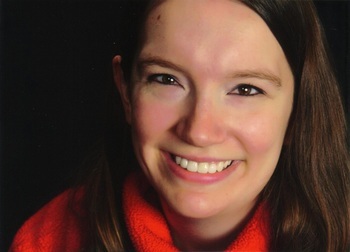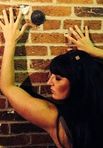Carpe Noctem Interview With Katie Manning
 Tasty Other, forthcoming November 2016, Main Street Rag Poetry Book Award Winner THINGS WE’RE DYING TO KNOW…
Tasty Other, forthcoming November 2016, Main Street Rag Poetry Book Award Winner THINGS WE’RE DYING TO KNOW…Let’s start with the book’s title and your cover image. How did you choose each? And, if I asked you to describe or sum up your book, what three words immediately come to mind?
The title comes from a poem that picks apart the sentence “Once upon a time, there was a mother,” and it sounds out the last word (mmm-other = tasty other).
I looked at potential cover art for months. One night, my husband found this image, and I loved it immediately. My book contains many poems that are based on bizarre dreams that I had during pregnancy, and there is one poem, “The Fall,” in which a baby’s leg pops off.
Three word summary: motherhood, transition, strange.
What were you trying to achieve with your book? Tell us about the world you were trying to create, and who lives in it.
I was trying to capture the experience of my first pregnancy and birth in all of its wonder, strangeness, and terror. I’m really fascinated by the identity shift that takes place and by all of the baggage that goes along with the mother label. The world of my book includes my experiences—real and dreamed—alongside mother figures from fairy tales, biblical narratives, and history.
Can you describe your writing practice or process for this collection? Do you have a favorite revision strategy?
For this collection, I decided to work with my pregnant body and all of the preoccupations that came with a first pregnancy. I immersed myself in everything pregnancy related—poetry, self-help books, fairy tales, and more.
My most-used revision strategy is to chop off lines at the beginning or end. I hate it actually, but I often have a better start or finish buried within the poem, so I do it.
How did you order the poems in the collection? Do you have a specific method for arranging your poems or is it sort of haphazard, like you lay the pages out on the floor and see what order you pick them back up in?
I went through so many different arrangements! The final order was influenced by feedback I received from editors at Sundress and ELJ Publications. I’m so grateful that they took the time to suggest more interesting ways that I might arrange the poems. The biggest change was taking the title poem and chopping it into nine parts to serve as section breaks throughout the book. I was resistant to trying it at first, but then it helped everything click into place.
What do you love to find in a poem you read, or love to craft into a poem you’re writing?
I love when a poem surprises me (when I’m reading or writing), and I love when a poem continues to haunt me long after I’ve read it.
Can you share an excerpt from your book? And tell us why you chose this poem for us to read – did it galvanize the writing of the rest of the collection? Is it your book’s heart? Is it the first or last poem you wrote for the book?
I’ll share “Sleeping Beauty’s Mother” because it’s one of my very favorite poems and it has not yet appeared online. This poem was published in print when it earned me The Nassau Review’s Author Award for Poetry. I was and still am so grateful for that affirmation of my work when I was in the midst of this project.
Sleeping Beauty’s Mother
A king and a queen wanted to have children.
They tried everything—
travel to drink the waters of the world
vows of silence, solitude, and celibacy
pilgrimages to trendy shrines
prayers to various gods and goddesses
—and nothing worked.
Finally, they tried sex.
The queen became pregnant.
The king chased after fairies.
Seven fairy godmothers came to give the baby gifts,
though the king didn’t bring the oldest fairy in the land,
so she brought herself and a curse to the shower:
The girl will prick her finger with a spindle. And die.
No, said the last young fairy,
the girl will only sleep for 100 years,
and she’ll wake to a prince’s kiss.
Everyone loved the lovely young fairy.
And everyone felt sorry for the little baby doll.
The king passed anti-spindle laws.
And the queen, tired of
swollen breasts
sleepless nights
a king who was too friendly with fairies
thought of a century of sleep
and a new young prince
and wished she had her daughter’s good luck.
If you had to convince someone walking by you in the park to read your book right then and there, what would you say?
“Hey, I just met you, and this is crazy, but here’s my new book. Read poems maybe?”
For you, what is it to be a poet? What scares you most about being a writer? Gives you the most pleasure?
I’ve been a poet since I was 4 and started creating poems. I’m most pleased when I’m in the midst of working on a poem. I’m most scared when I’ve finished a poem and feel like I might never be able to write another poem.
I’ve heard poets say that they’re writing the same story over and over in their poems. Is that true for you?
I don’t think so. I always write from my identities, interests, and current preoccupations, but those are complex and shifty. I sometimes look back at poems I wrote several years ago and think, “I wouldn’t write those now, but I’m glad that I wrote them then.”
Do you think poets have a responsibility as artists to respond to what’s happening in the world, and put that message out there? Does your work address social issues?
I don’t think poets have to respond directly to current events, but then I don’t think poems have to have a clear message. Some poems show us an image like a painting. Some play with sound. I do think that creating poems—and any act of artistic creation—is a way of responding to what’s happening in the world regardless of the content of those poems. To say that beauty and art matter in the face of violence and fear is radical.
Are there other types of writing (dictionaries, romance novels, comics, science textbooks, etc.) that help you to write poetry?
Yes. I made use of other poems, fairy tales, novels, the Bible, What to Expect When You’re Expecting, Wikipedia, and many more texts while writing this book. I was also influenced by my research on women writers of the Romantic period—Joanna Baillie, Anna Laetitia Barbauld and Felicia Hemans—who wrote poems in the voices of mothers addressing infants.
What are you working on now?
I’m revising a full-length Bible word banking manuscript (the chapbook version of this project is available from Agape Editions as A Door with a Voice ). I’m also working on a series of prose poems to/about my dead Granny and a series of poems that use my overflowing game closet as a starting place for exploring relationships and memory.
What book are you reading that we should also be reading?
Luci Shaw’s Sea Glass: New and Selected Poems. It’s good to be reminded that there’s beauty in this broken world.
Without stopping to think, write a list of five poets whose work you would tattoo on your body, or at least write in permanent marker on your clothing, to take with you at all times.Edna St. Vincent MillayGwendolyn BrooksAdrienne RichEmily Dickinson
*Stops to think despite the directions: Just one more? How to choose? Lucille Clifton, Audre Lorde, Sylvia Plath (no, perhaps not the best choice for a tattoo…), Carolyn Forche, Rita Dove, Mina Loy, or...*Katie Manning
***
Purchase Tasty Other.
 Katie Manning is the author of four poetry chapbooks, including The Gospel of the Bleeding Woman (Wipf and Stock, 2013) and A Door with a Voice (Agape Editions, 2016). She has received The Nassau Review Author Award for Poetry, and her writing has been published in Fairy Tale Review, New Letters, Poet Lore, So to Speak, Verse Daily, and many other journals and anthologies. She is the founding Editor-in-Chief of Whale Road Review and an Associate Professor of Writing at Point Loma Nazarene University in San Diego. Find her online at www.katiemanningpoet.com.
Katie Manning is the author of four poetry chapbooks, including The Gospel of the Bleeding Woman (Wipf and Stock, 2013) and A Door with a Voice (Agape Editions, 2016). She has received The Nassau Review Author Award for Poetry, and her writing has been published in Fairy Tale Review, New Letters, Poet Lore, So to Speak, Verse Daily, and many other journals and anthologies. She is the founding Editor-in-Chief of Whale Road Review and an Associate Professor of Writing at Point Loma Nazarene University in San Diego. Find her online at www.katiemanningpoet.com.
Published on September 14, 2016 08:46
No comments have been added yet.



